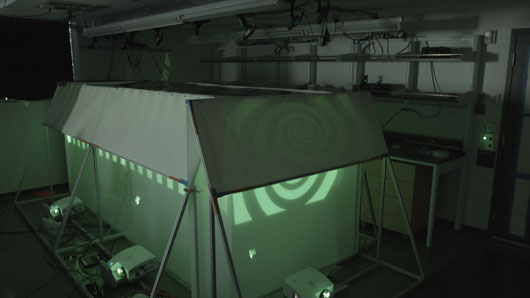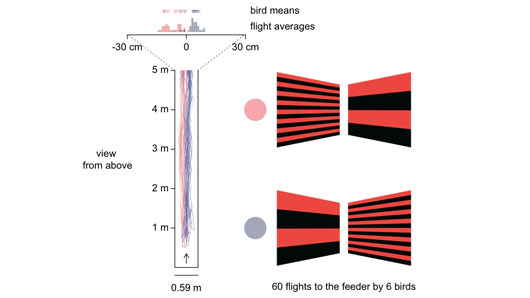Hummingbirds are able to cruise through trees at high speed, stop on a dime to feed at a flower, and catch a flying insect in the air, all with precision accuracy. A new study by R. Dakin et al. reveals how hummingbirds use visual cues to steer.
Previous studies of other bird species had suggested that flight control might be based on a strategy of balancing the translational motion of images on the left and right eye – an approach that has also been observed in flying insects. To test whether hummingbird flight is governed by the same rule, Doug Altshuler and his team at the University of British Columbia built a virtual reality flight tunnel where the motion of images projected on the walls could be manipulated via a series of synchronized AV projectors. The tunnel also included a multi-camera tracking system to record the birds’ flight trajectories in 3D.

Exterior view of the flight tunnel showing the synchronized projectors below. Eight high-speed video cameras mounted to the ceiling tracked the birds' flight trajectories in 3D. Note that in this photo the tunnel is configured for a follow-up experiment testing how birds control their speed.
Photo credit: Charlie Croskery
The team was able to test a wide variety of visual motions and patterns because nectar-feeding hummingbirds have to fly frequently to feed throughout the day. The results revealed that the birds would steer up or down to compensate for vertical image motion; however, they did not use the same strategy as insects of steering to balance image motion on the left and right side. Instead, the hummingbirds’ lateral steering was based on the vertical height of features: the birds would steer away from larger features even in the absence of image motion.

Figure: The hummingbirds steered toward smaller features and away from larger ones. The diagram on the left shows the flight tunnel from above, with coloured lines illustrating the paths taken by birds flying from the perch to the feeder. When the small horizontal features were presented on the left, the birds steered left (pink flights), whereas they steered right when the small horizontal features were on the right (blue flights).
These guidance rules may arise as a result of hummingbirds’ relatively poor visual acuity and rapid flight speeds, making feature size particularly important. Furthermore, as an object is approached, the changing size of its image on the retina can inform a bird about the exact time to collision – giving strategies based on monitoring size a major advantage over those based on translational image motion alone. Further studies are needed to test whether these rules are unique to hummingbirds as a result of their ability to make quick transitions between rapid and hovering flight. Understanding how birds control flight can help to inspire new ways to design autonomous flying vehicles as well as ways to prevent bird-building collisions, which kill millions of wild birds per year.
Reference
Visual guidance of forward flight in hummingbirds reveals control based on image features instead of pattern velocity. Dakin, R., Fellows, T. K., and D. L. Altshuler. 2016. Proceedings of the National Academy of Sciences. 113 (31): 8849-8854. doi: 10.1073/pnas.1603221113.


































